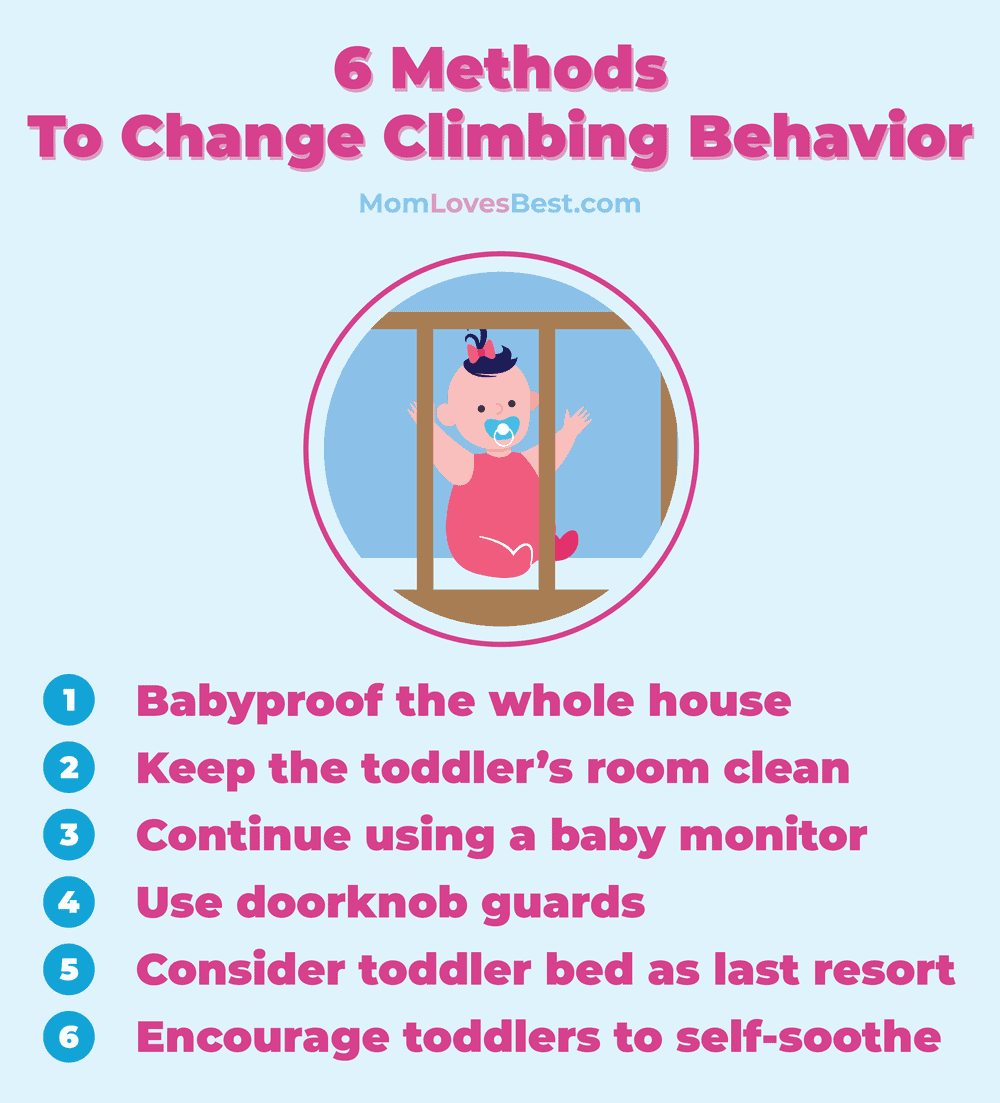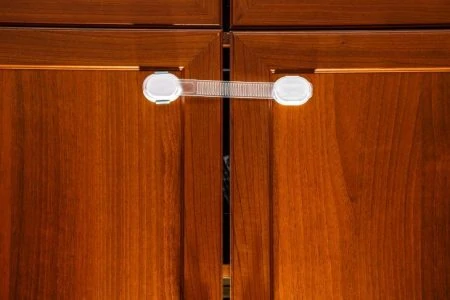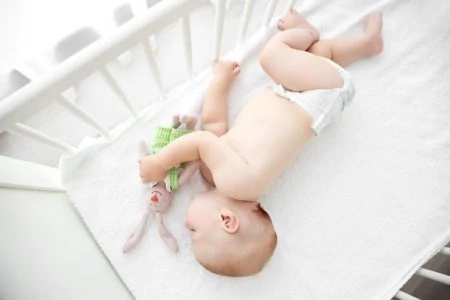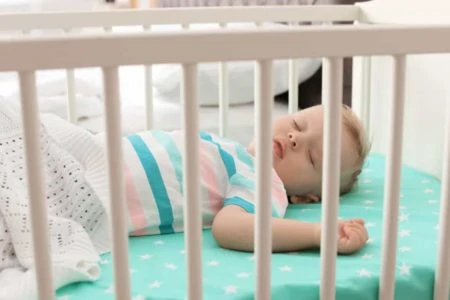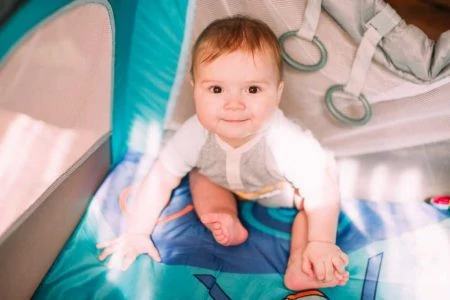Do you have a climber who is getting dangerously close to escaping their crib? Or have they already done it and tumbled to the floor?
We’ve been there and understand that fear — and the guilt of having a little one fall from their bed.
Before you make the rash decision to tie your kid to their crib (please, don’t do this!), we’ll share our tried and true methods for keeping busy toddlers safe in their beds. We’ll also discuss when you should consider using a toddler bed, how to make bedtime easier, and how to change climbing behavior.
Like any other behavior, crib climbing is a habit that can be caught and corrected with patience and a little help.
Key Takeaways
- Keep toddlers in a crib until they’re 3 years old to promote positive sleeping habits.
- Establish a consistent bedtime routine and gradually adjust bedtime based on your child’s natural sleep patterns.
- Prevent crib climbing by lowering the mattress, removing toys and pillows, and placing the crib against the wall.
- Encourage good behavior by using a toddler sleep sack, keeping the crib for sleep only, and silently returning your child to the crib if they climb out.
When To Use a Toddler Bed
Many parents jump right into putting their toddlers in a big kid bed when they make that first terrifying fall from the crib — or even when they begin to show signs of attempting their great escape.
It may seem like a good idea at first, but experts recommend that toddlers stay in a crib until they’re 3 years old. Waiting until this age helps promote positive sleeping habits teaches your child to stay in bed.
A problem many parents face when rushing their toddler into a bigger bed is that it gets harder to keep a curious kid contained.
Bigger beds are much easier to escape, making it far more difficult to teach good sleeping habits.
1. See It as a Lesson
It’s key to remember that toddlers who begin to climb from their cribs aren’t aware that what they’re doing is wrong.
Behaviors and habits can be changed with the correct teaching methods, though it can be frustrating when 3 a.m. rolls around and your little one is still trying to leap from the crib railing like a pro wrestler.
Addressing the issue early on and continuing to correct their behavior works in most cases, and your child should learn to stay in their designated sleeping spot pretty quickly.
2. Build a Bedtime Routine
Staying in the crib helps establish familiar bedtime routines and habits that will carry from crib to bed. It’s a difficult time in many households because children don’t always understand what a new bed means and why they have to sleep in it.
By sticking with a familiar place of rest and safety, you can implement a schedule that helps make your toddler’s eventual move to a bed easier.
Once you’ve successfully introduced a bedtime routine, you can start talking with your toddler about having their very first big kid bed. Getting them excited for it in advance can make the transition to a bed smoother.
Bedtime Tip
How Do I Keep My Toddler in the Crib?
So you’ve decided to keep your toddler in their crib, but how do you survive the dreaded climbing phase?
When you first start noticing your toddler beginning to climb out of the crib, make sure you’ve checked these things:
- Mattress settings: With many cribs, you can adjust the mattress to sit higher or lower. Put your toddler’s crib mattress as low as it will go to prevent them from climbing out. Do this as soon as they learn to pull themselves to a standing position.
- Remove toys and pillows: Children shouldn’t have pillows or toys in their cribs for the first year to help reduce the chance of SIDS. Even after the first year, keep your toddler’s crib bare, or they’ll be able to create steps out of their clutter (1).
- Put the lower end against the wall: Some cribs have a side that’s lower than the other. If this is the case for you, make sure this lower side is pushed against the wall so your child won’t have an easier escape route.
- Separate your kids: If you are a multi-child household, a well-meaning, bored sibling could be the accomplice to your toddler’s escape. Separating your kids’ sleep spaces will also provide fewer distractions, so they will both fall asleep easier too.
4 Ways To Change Climbing Behavior
Have you passed the initial preventative measures and still find your toddler giving it their all to escape the crib? Don’t despair! There are plenty of ways to start changing behaviors and encouraging a positive, obedient mindset towards sleeping.
For fast fixes, try out these tips for adventure-hungry kiddos.
1. Adjust Their Bedtime
As toddlers grow into their next stage of development, between ages 1 and 3, their internal clock changes too. Like older kids, a child’s natural need for sleep adjusts. Your restless toddler may just be a result of having a too-early bedtime.
Try documenting when your toddler actually falls asleep, as opposed to when you put them in their crib, and adjust your schedule to reflect their biological clock. Then you can gradually adjust these times by ten-minute increments each night after you’ve established a good bedtime routine and they’ve learned to stay still.
On the flip side, you may be putting your toddler to bed too late. Cranky, exhausted children who are beyond their limit will have a much harder time falling asleep and exhibit stubborn behavior to reflect that.
We recommend setting a bedtime between 7:30 p.m. and 8:30 p.m., depending on your toddler’s internal clock and your necessary wake-up time (2).
2. Try a Toddler Sleep Sack
We’ve learned all about the benefits of swaddling our infants, but have you considered extending the practice in a toddler-friendly way?
Introducing a toddler sleep sack to an avid climber can help them learn what they’re doing is wrong, stop them from climbing, and provide additional comfort.
Help your child understand what the sleep sack means by putting it on them at the same point in their bedtime routine every night. When you dress them up in it, they’ll figure out it’s a cue for bedtime and relaxation.
Look in your local baby store or online for safe, soft options.
3. Only Use the Crib for Sleeping
Sometimes it’s tempting to turn to the crib as a means of punishment or playtime. Putting your child into their crib when it’s not time for sleeping gives them the wrong idea of its purpose and may make it harder for them to understand why they have to stay inside at night.
Children associate their feelings with places very easily, so if you have an upset toddler, keep them out of the crib until they’ve calmed down.
By making the crib a place for sleep and only sleep, you’re setting them up for a firm understanding and a positive association with their designated area for bedtime. The best part? When you move them to a toddler bed, this behavior will carry over!
3. Return Your Toddler to the Crib Silently
Sometimes, toddlers keep climbing out of their crib to get their caregiver’s attention. By returning your child silently to the crib, you will decrease the likelihood that they do things other than sleep.
6 Methods if You Have a Climber
Before you treat yourself to something nice after finally getting your toddler to stay in the crib, make sure you’re prepared for a relapse in their behavior. Once a climber, always a climber!
You should always maintain safety — even after your toddler seems to have changed their climbing behavior.
1. Babyproof the Whole House
If your child is a skilled escape artist, don’t be fooled into thinking they’ll stay in their room quietly if they climb from the crib. Your little Houdini may have access to the whole house, so it’s essential to babyproof it entirely.
Baby gates should be up, electric outlet covers on, and anything harmful moved higher than your toddler’s reach.
2. Keep Your Toddler’s Room Clean
Not only should you minimize the clutter in their crib, for both safety reasons and to prevent them from climbing out, but you should keep the area around the crib clean too. Toddlers are curious! They have the instinct to explore, and they’ll be drawn to things that are left out.
Your toddler will be less tempted to try to leave their crib if you store toys out of sight. It also keeps your child safe if they do escape.
3. Continue Using a Baby Monitor
Investing in a good video baby monitor is one of the most important purchases you should consider making as a parent, even before your toddler decides to launch themselves over the crib railing.
By keeping an eye on their actions before they drift off to sleep, you can stay diligent and proactive in stopping their behavior while also eliminating the risk of falling before it happens.
Sure, we all have a set of eyes in the back of her head, but baby monitors are our favorite backup for when those eyes get tired.
4. Use Doorknob Guards
For parents of anyone under the age of 2, doorknob guards are a gift. By preventing access to certain rooms or keeping a toddler in their room during the night, you reduce the risk of them accessing other dangers.
If your toddler still doesn’t stay in their crib, it may be time to move them to a toddler bed and see if it offers any improvement. Making the transition is different for every child, but they’ll quickly adjust if you explain it to your toddler and walk them through this new change in their bedtime routine.
Some toddlers do better in a bed, so the best person to make this decision is the one who knows them best — that’s you, mom!
5. Consider a Toddler Bed as a Last Resort
If you have a toddler who keeps climbing out of bed despite using all the methods discussed in this article, consider switching to a toddler bed, assuming your toddler is at least 18 months old. You can use strategies in this video to keep the toddler in bed.
6. Encourage Toddlers to Self-Soothe With the Extinction (Ignoring) Method
If you have a toddler who cannot fall asleep, consider the possibility of childhood insomnia. Toddlers who have trouble falling asleep before the age of 2 often have trouble self-soothing. If your toddler is trying to get your attention or making demands during bedtime, ignore their attempts. It may seem difficult at first, but it is an effective way to teach them how to self-soothe to make sleeping easier (3).
How To Make Bedtime Easier
If your family is anything like ours, nighttime can be the biggest stress of the day. From cranky attitudes to strong-willed fighters who hate bedtime, getting everyone tucked away safe and sound can be a major pain — especially if you’re already tired.
Making bedtime easier should be a priority, especially for kids ages 3 and under. Establishing a simple routine as soon as possible will make future transitions and changes much smoother, giving you a better sleep too.
Start by sticking to a schedule, even if they beg and plead for more time awake. Picking your battles is important, but bedtime should be a time your whole family sticks to. Children love and need routine — even if they don’t want you to know that!
Get your kids excited about bedtime by including one or two fun activities reserved for naps or nighttime, like reading, and really talk them up. Use games, songs, and even rewards to encourage a positive attitude toward bedtime.


